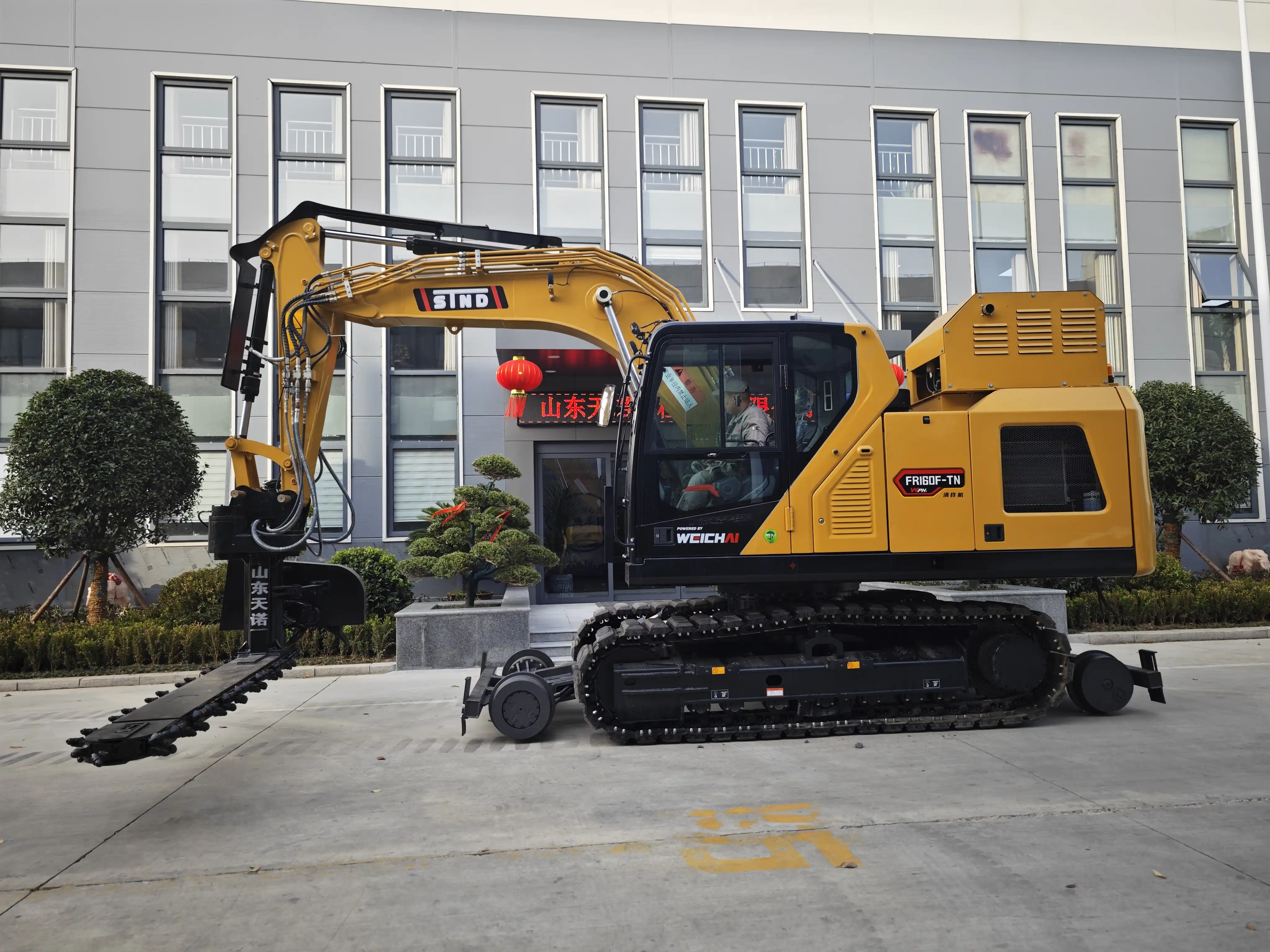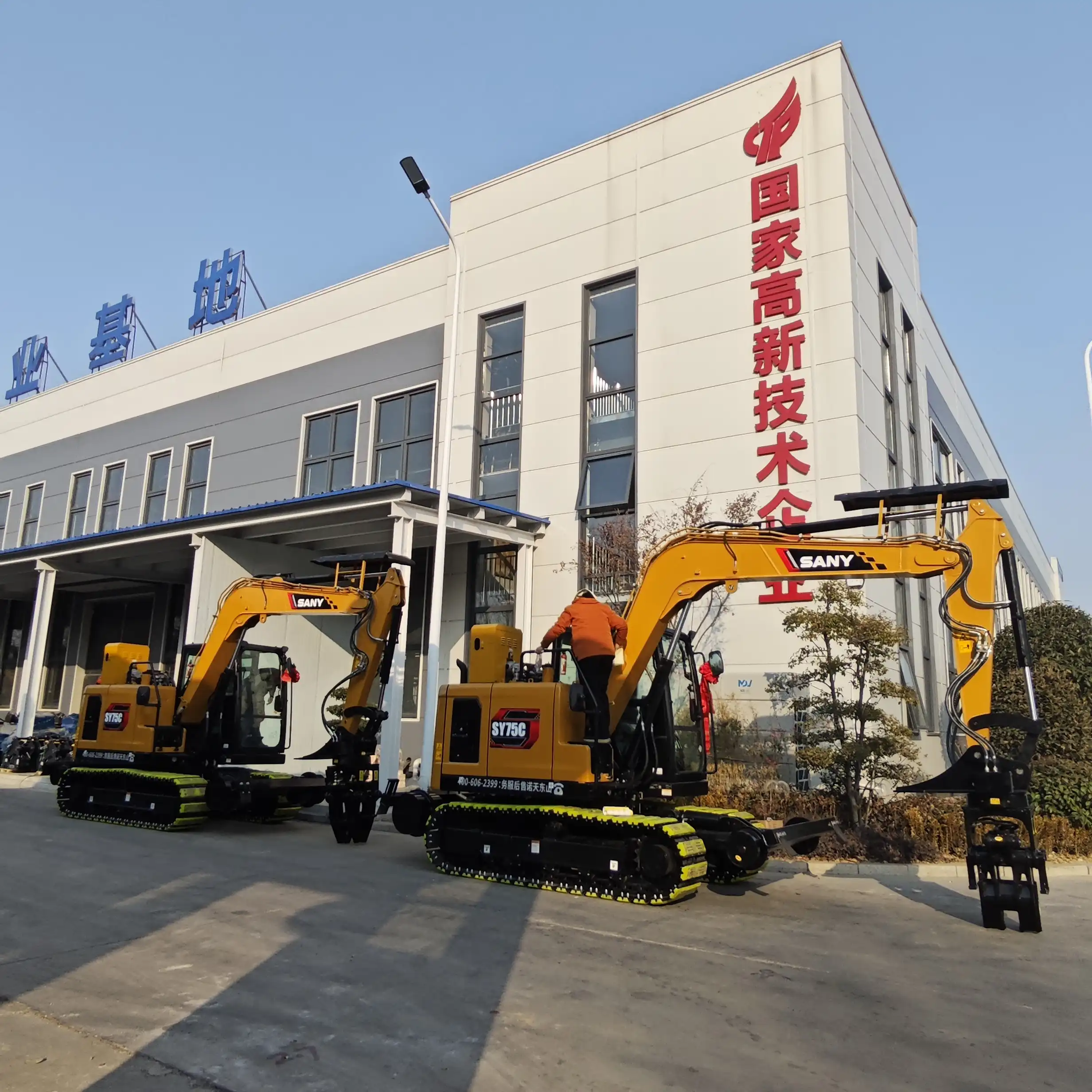How does the Ballast Blaster Undercutter work?
The ballast blaster undercutter operates through a sophisticated mechanical process designed specifically for railway track maintenance. This specialized piece of equipment extracts contaminated ballast from beneath railway sleepers, screens it to remove debris, and redistributes clean ballast back to maintain proper track stability and drainage. Working with a lateral incision mode, the machine can excavate up to 200mm beneath the sleepers while rotating a full 360 degrees to access difficult areas. The undercutter's efficient design allows it to clean more than 20 meters of track per hour with minimal manual intervention. As it moves alongside the track, the undercutter's powerful excavation system lifts the ballast, separates waste materials through advanced screening technology, and precisely places the cleaned materials back into position. This comprehensive process not only extends the lifespan of railway tracks but also significantly improves safety by ensuring proper drainage and preventing track deformation caused by contaminated ballast.
Remove Contaminated Ballast Rock And Mud

The Purpose of Ballast Cleaning
Railway ballast serves as the foundation for track structures, providing essential drainage, load distribution, and track stability. Over time, however, this crucial component becomes contaminated with mud, debris, and fine particles that compromise its functionality. When ballast becomes fouled with these contaminants, it loses its ability to drain properly, leading to water retention that can destabilize the track structure. Additionally, contaminated ballast no longer provides adequate support for sleepers, resulting in uneven track surfaces that pose significant safety risks and reduce operational efficiency.
The ballast blaster undercutter addresses these issues by systematically removing contaminated materials from beneath and around the track structure. This cleaning process is vital for maintaining proper track geometry, preventing premature track deterioration, and ensuring trains can operate at designed speeds without restrictions. Proper ballast maintenance using undercutters can extend track lifespan by up to 25%, representing substantial cost savings compared to complete track replacement.
Extraction Mechanism
The extraction mechanism of a modern ballast blaster undercutter represents a significant engineering achievement in railway maintenance technology. At its core, the system employs a powerful cutting chain that moves through the ballast bed at a precisely controlled depth—typically up to 200mm beneath the sleepers. This cutting chain features specially designed teeth that break up compacted material while minimizing damage to underlying structures.
Separation Of Waste Materials
Once extracted from beneath the track, the contaminated ballast undergoes a sophisticated separation process. The ballast blaster undercutter employs a multi-stage screening system designed to efficiently separate clean ballast from various contaminants including mud, vegetation, coal dust, and other debris.
The initial separation occurs on primary vibrating screens that remove larger contaminants while allowing smaller particles to fall through to secondary screening stages. These subsequent screening levels utilize progressively finer mesh configurations to capture particles of different sizes. The machine's advanced vibration technology ensures that even materials with similar dimensions but different densities can be effectively separated.
The separation system's efficiency directly impacts the quality of the finished track, as even small percentages of remaining contaminants can significantly reduce the ballast bed's drainage capacity and structural stability. Tiannuo's ballast cleaning technology achieves contamination removal rates exceeding 95%, ensuring optimal track performance following maintenance operations.
Undercutter Attachment: Mode-Lateral Incision

Technical Specifications
The lateral incision mode represents the primary operational configuration for the ballast blaster undercutter, enabling precise intervention beneath track structures without necessitating complete track removal. This technological approach provides remarkable efficiency advantages compared to traditional maintenance methods. The FR-160F-TN model features an impressive effective mining length of at least 2800mm, which can be customized according to specific project requirements.
The machine's excavation depth capability extends to 200mm beneath the sleepers, allowing for comprehensive removal of contaminated materials throughout the critical load-bearing zone of the ballast bed. This depth specification ensures that virtually all fouled material can be accessed and processed. The lateral cutting mechanism incorporates hardened steel components capable of withstanding continuous operation in abrasive environments while maintaining dimensional stability.
With external dimensions of 4000×1100×1650mm, the undercutter offers an optimal balance between operational capability and maneuverability in confined railway corridors. The unit's compact profile enables deployment even in areas with restrictive clearance limitations such as tunnels or platforms. Despite its relatively compact dimensions, the machine delivers exceptional mining efficiency exceeding 20 meters per hour under typical operating conditions.
Excavation Process
The excavation process begins with precise positioning of the ballast blaster undercutter along the section of track requiring maintenance. Once in position, the operator initiates the lateral incision sequence, which deploys the cutting chain beneath the track structure at the predetermined depth. As the cutting chain engages with the ballast, it creates a horizontal plane of excavation that progressively advances along the track.
During excavation, the machine continuously monitors cutting resistance and adjusts operational parameters accordingly. When encountering zones of heavily compacted or severely contaminated ballast, the system may temporarily reduce advancement speed while increasing cutting energy to maintain consistent material flow. This intelligent adaptation prevents system overloading while optimizing productivity across varying conditions.
The excavation process proceeds with meticulous precision, maintaining strict geometric tolerances to ensure proper track support following maintenance. The undercutter's advanced guidance systems reference the existing track position to establish ideal cutting profiles that preserve the intended track geometry. This precision prevents unintended alterations to track alignment that might otherwise require additional corrective measures.
As excavation progresses, the loosened ballast transfers automatically to the machine's screening systems through a series of conveyor mechanisms designed to prevent material spillage. The entire excavation sequence operates as a continuous process, with material extraction, screening, and redistribution occurring simultaneously to maximize operational efficiency. This integrated approach enables the FR-160F-TN to achieve its remarkable productivity rates while maintaining exceptional quality standards.
Alongside The Track

Strategic Positioning
Effective operation of the ballast blaster undercutter requires strategic positioning alongside the railway track to maximize productivity while minimizing disruption to adjacent infrastructure. The machine typically operates from the track shoulder area, which provides stable ground for the equipment while allowing direct access to the ballast bed beneath the sleepers. This positioning strategy enables continuous operation without occupying the track itself, potentially allowing maintenance activities to occur during limited traffic periods rather than requiring complete line closures.
Prior to deployment, maintenance teams conduct comprehensive site assessments to identify optimal positioning locations that account for factors including ground stability, access requirements, and proximity to fixed infrastructure. These assessments frequently incorporate ground-penetrating radar surveys to identify subsurface obstacles or utilities that might interfere with excavation operations. By identifying these potential complications in advance, teams can develop mitigation strategies that prevent costly operational delays.
The strategic positioning process also involves establishing material handling logistics, particularly for the disposal of excavated waste materials. The ballast cleaning operation can generate significant volumes of contaminated material that must be properly managed. Positioning decisions therefore consider access routes for support equipment such as dump trucks or material handling machines that will transport waste material away from the worksite.
Environmental Considerations
Modern ballast blaster undercutter operations incorporate numerous features designed to minimize environmental impact while maximizing maintenance effectiveness. Dust suppression systems represent a primary environmental control measure, utilizing precisely controlled water spray systems at key points throughout the material handling process. These systems effectively contain particulate emissions that might otherwise create air quality concerns for workers and surrounding areas.
Noise mitigation features include acoustic enclosures around major mechanical components and vibration isolation systems that reduce sound transmission. These features prove particularly important when maintenance activities occur near residential areas or during nighttime hours. The FR-160F-TN model incorporates advanced sound-dampening technologies that reduce operational noise levels by up to 30% compared to previous-generation equipment.
FAQ
①How often should ballast cleaning be performed?
Ballast cleaning frequency varies based on traffic volume, environmental conditions, and track design. Typically, main lines require cleaning every 8-15 years, while secondary lines may extend to 15-25 years. Regular track inspections measuring drainage performance and ballast contamination levels determine optimal timing.
②What are the signs that ballast needs cleaning?
Key indicators include visible mud pumping during train passage, standing water after rainfall, excessive track settlement requiring frequent geometry corrections, vegetation growth in the ballast, and increased track movement under load. Proactive testing measuring fouling index can identify cleaning needs before severe performance degradation occurs.
③Can the ballast blaster undercutter operate in all weather conditions?
The ballast blaster undercutter can operate in most weather conditions, including light precipitation and moderate temperature extremes. However, heavy rainfall can reduce screening efficiency, and frozen ground conditions may require specialized cutting components. Extreme heat may necessitate reduced operational periods to prevent component overheating.
④What happens to the waste material removed during cleaning?
Waste material typically undergoes environmental testing to determine appropriate disposal methods. Clean materials may be repurposed for non-critical applications like access roads or embankment stabilization. Contaminated materials require proper disposal at approved facilities. Some operations incorporate on-site remediation systems for processing contaminated materials.
Contact Tiannuo Machinery
Tiannuo Machinery's undercutters, like the FR-160F-TN mode, achieve remarkable productivity rates exceeding 20 meters per hour while maintaining exceptional quality standards. This efficiency translates directly to reduced maintenance costs and minimized service disruptions for railway operators. The technology's environmental considerations, including dust suppression and waste management features, ensure that maintenance activities proceed with minimal impact on surrounding areas.
As railway networks continue to face increasing demands for reliability and throughput, the importance of effective ballast maintenance grows accordingly. The ballast blaster undercutter provides the technological foundation for meeting these challenges by extending infrastructure lifespan and maintaining optimal performance characteristics. For more information about Tiannuo's railway maintenance equipment and customized solutions, please contact us at arm@stnd-machinery.com.
References
Railway Track Maintenance: Principles and Technology. International Journal of Railway Engineering, Volume 43, Issue 2.
Advances in Ballast Cleaning Technology for Modern Railways. Engineering Technology Review, 2023 Edition.
Environmental Considerations in Railway Maintenance Operations. Journal of Sustainable Infrastructure, Volume 18.
Performance Analysis of Modern Ballast Undercutting Equipment. Railway Technical Review, Issue 127.
About Author: Arm
Arm is a leading expert in the field of specialized construction and railway maintenance equipment, working at Tiannuo Company.

